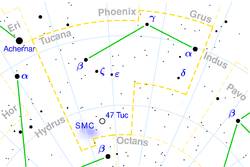きょしちょう座ゼータ星
きょしちょう座ζ星(きょしちょうざゼータせい、ζ Tuc / ζ Tucanae)は、きょしちょう座の恒星で4等星。黄白色の主系列星。
| きょしちょう座ζ星 Zeta Tucanae | ||
|---|---|---|
| 星座 | きょしちょう座 | |
| 見かけの等級 (mv) | 4.23 | |
| 変光星型 | なし[1] | |
| 位置 元期:J2000.0 | ||
| 赤経 (RA, α) | 00h 20m 04.2601s[2] | |
| 赤緯 (Dec, δ) | –64° 52′ 29.246″[2] | |
| 視線速度 (Rv) | 8.80 ± 0.48 km/s[3] | |
| 固有運動 (μ) | 赤経: 1,707.35 ミリ秒/年[2] 赤緯: 1,165.60 ミリ秒/年[2] | |
| 年周視差 (π) | 116.46 ± 0.16 ミリ秒[3] | |
| 距離 | 28.0 光年 (8.59 パーセク) | |
| 絶対等級 (MV) | 4.56[4] | |
きょしちょう座ζ星の位置
| ||
| 物理的性質 | ||
| 半径 | 1.05 R☉[5] | |
| 質量 | 0.995 M☉[4] | |
| 表面重力 | 33 G[4] | |
| 自転速度 | 3.0 km/s[6] | |
| スペクトル分類 | F9.5 V[2] | |
| 光度 | 1.218 L☉[4] | |
| 表面温度 | 5,977 K[4] | |
| 色指数 (B-V) | 0.58[7] | |
| 色指数 (U-B) | 0.02[7] | |
| 金属量[Fe/H] | –0.18(太陽比)[4] | |
| 年齢 | 3.82 ×109 年[8] | |
| 他のカタログでの名称 | ||
| GJ 17, HR 77, HD 1581, LHS 5, LTT 167, GCTP 54, SAO 248163, CP(D)-65°13, FK5 10, GC 401, LPM 16, LFT 36, HIP 1599.[9] | ||
| ■Template (■ノート ■解説) ■Project | ||
特徴 編集
質量、半径は太陽とほぼ同じだが、表面温度が太陽よりやや高いので、太陽よりも明るい[10][4]。ヒッパルコスによる視差の測定から、距離は精度良く求まっており、地球からの距離は約28.0光年である[2]。
| 太陽 | きょしちょう座ζ星 |
|---|---|
金属量は太陽より少なく、太陽のおよそ7割程度だが、それ以外の性質はよく似ており、年齢も約38億歳と推定され[8]、太陽と大きな違いはない。そのため、この恒星にもし地球型惑星が存在すれば、生命探査の絶好の目標となる[11]。
きょしちょう座ζ星は、おおぐま座運動星団に属している。これは、宇宙空間で同じ運動を持つ恒星の緩い集まりである[12]。運動速度は、U = -60, V = -4, W = -38 km/sである。これらはそれぞれ、銀河中心への運動速度、銀河の自転方向の運動速度、銀河の北極方向への運動速度に対応する[13]。銀河核から平均8,400パーセクの位置を、軌道離心率0.16で公転している[11]。
星周構造 編集
波長70μmの遠赤外線が過剰に放射されていることから、この星系は星周塵の円盤を伴っていると考えられる[14]。分光観測でも円盤が存在する証拠が得られている[5]。円盤は、半径が少なくとも2.3AUで、恒星の周囲を公転しており、温度は最高で218Kと推定される[14]。2009年時点で惑星は見つかっていない[15]。視線速度の変化の観測からは、少なくとも木星サイズの惑星の存在は否定される[11]。
出典 編集
- ^ Adelman, S. J. (February 2001). “Research Note Hipparcos photometry: The least variable stars”. Astronomy and Astrophysics 367: 297–298. Bibcode: 2001A&A...367..297A. doi:10.1051/0004-6361:20000567.
- ^ a b c d e f Perryman, M. A. C.; et al. (July 1997). “The HIPPARCOS Catalogue”. Astronomy & Astrophysics 323: L49–L52. Bibcode: 1997A&A...323L..49P.
- ^ a b de Bruijne, J. H. J.; Eilers, A.-C. (2012-10), “Radial velocities for the HIPPARCOS-Gaia Hundred-Thousand-Proper-Motion project”, Astronomy and Astrophysics 546: A61, Bibcode: 2012A&A...546A..61D
- ^ a b c d e f g Sousa, S. G.; et al. (2008-08), “Spectroscopic parameters for 451 stars in the HARPS GTO planet search program. Stellar [Fe/H] and the frequency of exo-Neptunes”, Astronomy and Astrophysics 487 (1): 373-381, Bibcode: 2008A&A...487..373S, doi:10.1051/0004-6361:200809698
- ^ a b Rojas, M.; et al. (2013-12), “Analysis of the Chemical Composition of the Atmospheres of Stars with Debris Disks and Planetary Systems”, Astrophysics 56 (4): 461-471, Bibcode: 2013Ap.....56..461R, doi:10.1007/s10511-013-9300-y
- ^ O'Toole, S. J.; et al (2009-08), “The Frequency of Low-mass Exoplanets”, Astrophysical Journal 701 (2): 1732-1741, Bibcode: 2009ApJ...701.1732O, doi:10.1088/0004-637X/701/2/1732
- ^ a b Johnson, H. L.; Iriarte, B.; Mitchell, R. I.; Wisniewskj, W. Z. (1966). “UBVRIJKL photometry of the bright stars”. Communications of the Lunar and Planetary Laboratory 4 (99). Bibcode: 1966CoLPL...4...99J.
- ^ a b Gáspár, András; Rieke, George H.; Balog, Zoltán (2013-05), “The Collisional Evolution of Debris Disks”, Astrophysical Journal 768 (1): 25, Bibcode: 2013ApJ...768...25G, doi:10.1088/0004-637X/768/1/25
- ^ “zet Tuc -- High proper-motion Star”. SIMBAD. Centre de Données astronomiques de Strasbourg. 2010年5月21日閲覧。
- ^ Santos, N. C.; Israelian, G.; Mayor, M. (July 2001). “The metal-rich nature of stars with planets”. Astronomy and Astrophysics 373: 1019–1031. Bibcode: 2001A&A...373.1019S. doi:10.1051/0004-6361:20010648.
- ^ a b c Porto de Mello, Gustavo; del Peloso, Eduardo F.; Ghezzi, Luan (April 2006). “Astrobiologically Interesting Stars Within 10 Parsecs of the Sun”. Astrobiology 6 (2): 308–331. Bibcode: 2006AsBio...6..308P. doi:10.1089/ast.2006.6.308. PMID 16689649.
- ^ Castro, S.; Porto de Mello, G. F.; da Silva, L. (May 1999). “Copper and barium abundances in the Ursa Major Moving Group”. Monthly Notices of the Royal Astronomical Society 305 (3): 693–700. Bibcode: 1999MNRAS.305..693C. doi:10.1046/j.1365-8711.1999.02455.x.
- ^ Woolley, Richard van der Riet (1970). “Catalogue of Stars within 25 Parsecs of the Sun”. Royal Observatory Annals (Herstmonceux, Royal Greenwich Observatory) 5 2009年9月2日閲覧。.
- ^ a b Trilling, D. E.; Bryden, G.; Beichman, C. A.; Rieke, G. H.; Su, K. Y. L.; Stansberry, J. A.; Blaylock, M.; Stapelfeldt, K. R. et al. (February 2008). “Debris Disks around Sun-like Stars”. The Astrophysical Journal 674 (2): 1086–1105. Bibcode: 2008ApJ...674.1086T. doi:10.1086/525514.
- ^ Kóspál, Ágnes; Ardila, David R.; Moór, Attila; Ábrahám, Péter (August 2009). “On the Relationship Between Debris Disks and Planets”. The Astrophysical Journal Letters 700 (2): L73–L77. Bibcode: 2009ApJ...700L..73K. doi:10.1088/0004-637X/700/2/L73.
外部リンク 編集
- Zeta Tucanae at SolStation.
- Zeta Tuc by Jim Kaler
